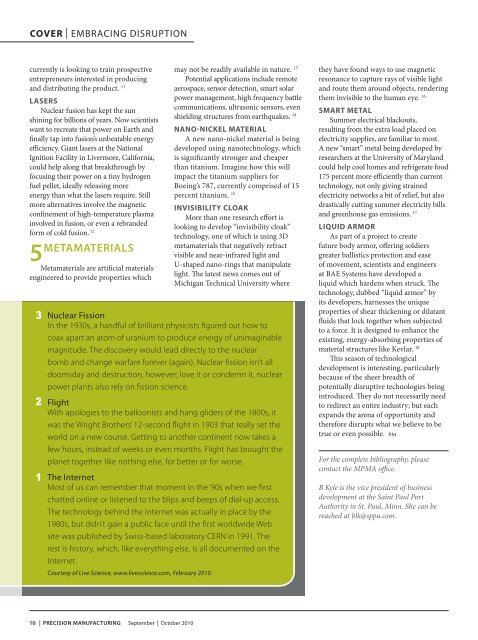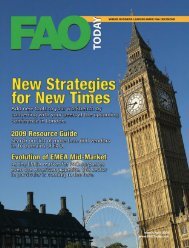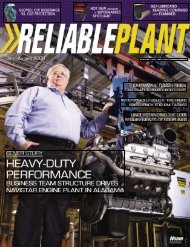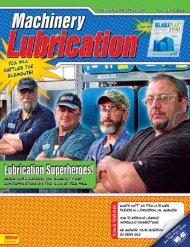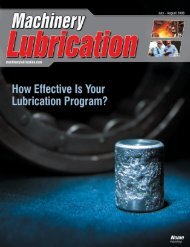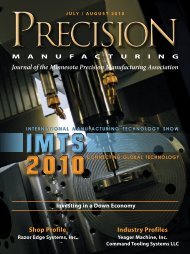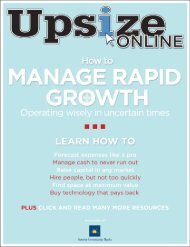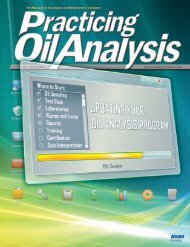DESIGNING THE FUTURE
DESIGNING THE FUTURE
DESIGNING THE FUTURE
Create successful ePaper yourself
Turn your PDF publications into a flip-book with our unique Google optimized e-Paper software.
cover | Embracing Disruption<br />
currently is looking to train prospective<br />
entrepreneurs interested in producing<br />
and distributing the product. 11<br />
Lasers<br />
Nuclear fusion has kept the sun<br />
shining for billions of years. Now scientists<br />
want to recreate that power on Earth and<br />
finally tap into fusion’s unbeatable energy<br />
efficiency. Giant lasers at the National<br />
Ignition Facility in Livermore, California,<br />
could help along that breakthrough by<br />
focusing their power on a tiny hydrogen<br />
fuel pellet, ideally releasing more<br />
energy than what the lasers require. Still<br />
more alternatives involve the magnetic<br />
confinement of high-temperature plasma<br />
involved in fusion, or even a rebranded<br />
form of cold fusion. 12<br />
5 Metamaterials<br />
Metamaterials are artificial materials<br />
engineered to provide properties which<br />
3<br />
2<br />
1<br />
may not be readily available in nature. 13<br />
Potential applications include remote<br />
aerospace, sensor detection, smart solar<br />
power management, high frequency battle<br />
communications, ultrasonic sensors, even<br />
shielding structures from earthquakes. 14<br />
Nano-nickel Material<br />
A new nano-nickel material is being<br />
developed using nanotechnology, which<br />
is significantly stronger and cheaper<br />
than titanium. Imagine how this will<br />
impact the titanium suppliers for<br />
Boeing’s 787, currently comprised of 15<br />
percent titanium. 15<br />
Invisibility Cloak<br />
More than one research effort is<br />
looking to develop “invisibility cloak”<br />
technology, one of which is using 3D<br />
metamaterials that negatively refract<br />
visible and near-infrared light and<br />
U-shaped nano-rings that manipulate<br />
light. The latest news comes out of<br />
Michigan Technical University where<br />
Nuclear Fission<br />
In the 1930s, a handful of brilliant physicists figured out how to<br />
coax apart an atom of uranium to produce energy of unimaginable<br />
magnitude. The discovery would lead directly to the nuclear<br />
bomb and change warfare forever (again). Nuclear fission isn’t all<br />
doomsday and destruction, however; love it or condemn it, nuclear<br />
power plants also rely on fission science.<br />
Flight<br />
With apologies to the balloonists and hang gliders of the 1800s, it<br />
was the Wright Brothers’ 12-second flight in 1903 that really set the<br />
world on a new course. Getting to another continent now takes a<br />
few hours, instead of weeks or even months. Flight has brought the<br />
planet together like nothing else, for better or for worse.<br />
The Internet<br />
Most of us can remember that moment in the ‘90s when we first<br />
chatted online or listened to the blips and beeps of dial-up access.<br />
The technology behind the Internet was actually in place by the<br />
1980s, but didn’t gain a public face until the first worldwide Web<br />
site was published by Swiss-based laboratory CERN in 1991. The<br />
rest is history, which, like everything else, is all documented on the<br />
Internet.<br />
Courtesy of Live Science, www.livescience.com, February 2010.<br />
they have found ways to use magnetic<br />
resonance to capture rays of visible light<br />
and route them around objects, rendering<br />
them invisible to the human eye. 16<br />
Smart Metal<br />
Summer electrical blackouts,<br />
resulting from the extra load placed on<br />
electricity supplies, are familiar to most.<br />
A new “smart” metal being developed by<br />
researchers at the University of Maryland<br />
could help cool homes and refrigerate food<br />
175 percent more efficiently than current<br />
technology, not only giving strained<br />
electricity networks a bit of relief, but also<br />
drastically cutting summer electricity bills<br />
and greenhouse gas emissions. 17<br />
Liquid Armor<br />
As part of a project to create<br />
future body armor, offering soldiers<br />
greater ballistics protection and ease<br />
of movement, scientists and engineers<br />
at BAE Systems have developed a<br />
liquid which hardens when struck. The<br />
technology, dubbed “liquid armor” by<br />
its developers, harnesses the unique<br />
properties of shear thickening or dilatant<br />
fluids that lock together when subjected<br />
to a force. It is designed to enhance the<br />
existing, energy-absorbing properties of<br />
material structures like Kevlar. 18<br />
This season of technological<br />
development is interesting, particularly<br />
because of the sheer breadth of<br />
potentially disruptive technologies being<br />
introduced. They do not necessarily need<br />
to redirect an entire industry; but each<br />
expands the arena of opportunity and<br />
therefore disrupts what we believe to be<br />
true or even possible. PM<br />
For the complete bibliography, please<br />
contact the MPMA office.<br />
B Kyle is the vice president of business<br />
development at the Saint Paul Port<br />
Authority in St. Paul, Minn. She can be<br />
reached at blk@sppa.com.<br />
10 | PRECISION MANUFACTURING September | October 2010


